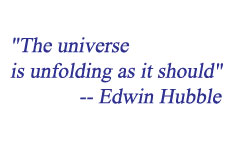The expanding universe: discovered by Hubble
Think you've established your place in the universe? Think again.
Your position right now isn't the same as it was just a second ago. As you
read this article, our galaxy, theMilky Way, is
hurtling through the universe at a speed of several hundred kilometers a
second. At the same time, our neighboring galaxies, scattered throughout
space, are speeding farther away from us and each other. In essence, our
universe is expanding.
For such a fundamental assumption of modern
astronomy, the realization that the universe is growing is relatively new.
Only 74 years ago, scientists were aware of little motion outside the
comparatively static interior of the Milky Way. The revelations of a
single researcher, Edwin Hubble, rushed expansion straight to the
forefront, opening up the entire branch of astronomy known as cosmology.
His famous paper, published in PNAS in 1929 (see reference 1), proved with
observational evidence that galaxies are moving away from us with a speed
proportional to their distance. Hubble's revolutionary vision of a
swelling cosmos gave astronomers new insight into the birth of our
universe, as well as a glimpse of its future evolution.
|
Measuring Success in Light Years

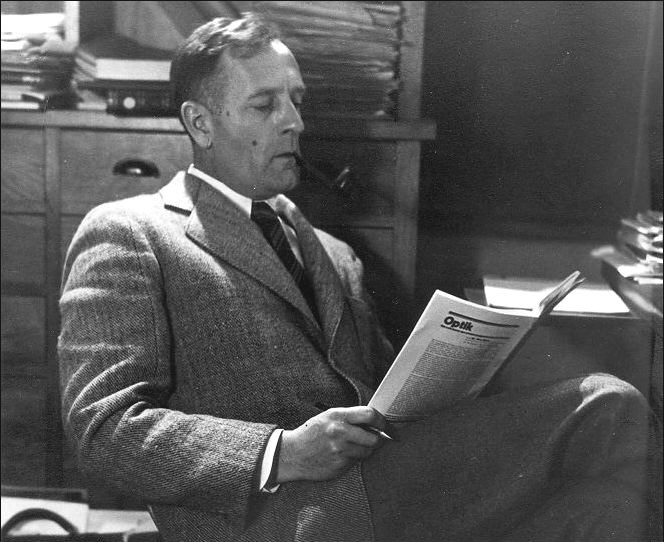 |
| Edwin Hubble, January 1940. ©
Copyright California Institute of
Technology. | | |
Hubble's early meanderings almost detoured him completely from a
career in astronomy and gave no indication of his ultimate role as the
"father of cosmology." After receiving an undergraduate degree in
mathematics and astronomy from the University of Chicago, Hubble made a
promise to his dying father to study law. His intelligence and athleticism
helped him land a prestigious Rhodes scholarship to Oxford University, where he ran track,
played baseball and basketball, and boxed while earning his law degree. As
a new attorney, Hubble joined the Kentucky bar association upon his return
to the United States, but switched tracks again to teach high school
Spanish.
However, Hubble's heart was with the stars. After one year as a
high school teacher, he signed on as a graduate student at Yerkes
Observatory at the University of Chicago and earned his PhD in astronomy.
Although a short term as an enlisted soldier in World War I almost
sidetracked him once again, Hubble was invited to join the staff of Mt. Wilson Observatory in
1919.
The 100-inch telescope at Mt. Wilson, high above Pasadena, CA, was
the most powerful in the world at the time. Hubble first set his sights on
using the telescope to elucidate the nature of galactic nebulae--fuzzy,
glowing patches then thought to be clouds of burning gas. After resolving
individual bright spots in several of the nebulae, Hubble decided that the
nebulae were remote clusters of stars. However, the exact distance between
these clusters and the earth was a mystery.
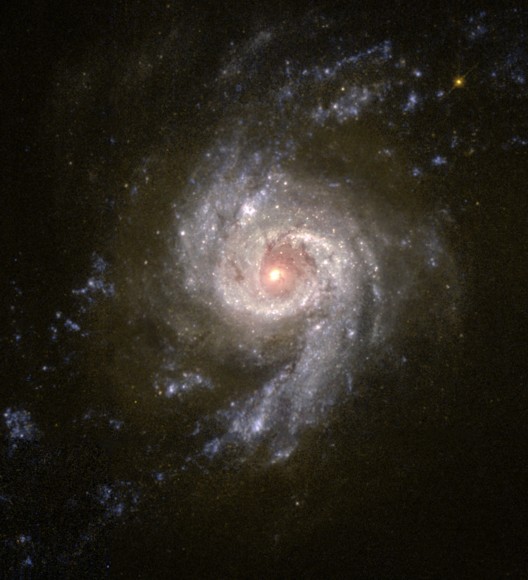 |
| Galaxy NGC 3310, as seen from the
Hubble Space Telescope. Space Telescope Science
Institute.
| | |
According to Martha
Haynes, an Academy member and Cornell University astronomer, many
contemporary scientists believed that the Milky Way was the entire
universe. Were these nebulae at the edges of the Milky Way, or were they
possibly "island universes" far away from our own? Hubble would later
derive the answer from computing the distance to these star clusters and
comparing it with the known edge of the Milky Way--not a minor task when
distances can extend to millions of light years.
"It's not a trivial job in astronomy when you can't go out and walk
across the field and measure how far it is, or send someone out to make a
roadmap," said Haynes.
However, in the early 1900s, astronomer Henrietta
Leavitt perfected a technique to gauge the distance to a type of star
known as a Cepheid
variable (2). These stars
vary in brightness over a period related to their distance. With the
powerful Mt. Wilson telescope, Hubble was able to spot Cepheid variable
stars in the nebulae and calculate their approximate distance. The
measurements far exceeded any distances for stars in the Milky Way,
leading Hubble to conclude that the nebulae were spiral galaxies much like
our own. He published this research in 1925 in The Astrophysical Journal
(3).
|
|
A Universe Like Raisin Cake

Concurrent with Hubble's research, other scientists were studying
Doppler
shifts in the light coming from galaxies. Like the change in pitch
from a passing car radio, light waves also change in frequency with
velocity. The effect is invisible to the naked eye, but it is detectable
with measurements taken from photographic plates. Hubble's contemporary
researchers had noticed that many of the  galaxies were redder than they
should be--a possible indicator that the galaxies were moving
away. galaxies were redder than they
should be--a possible indicator that the galaxies were moving
away.
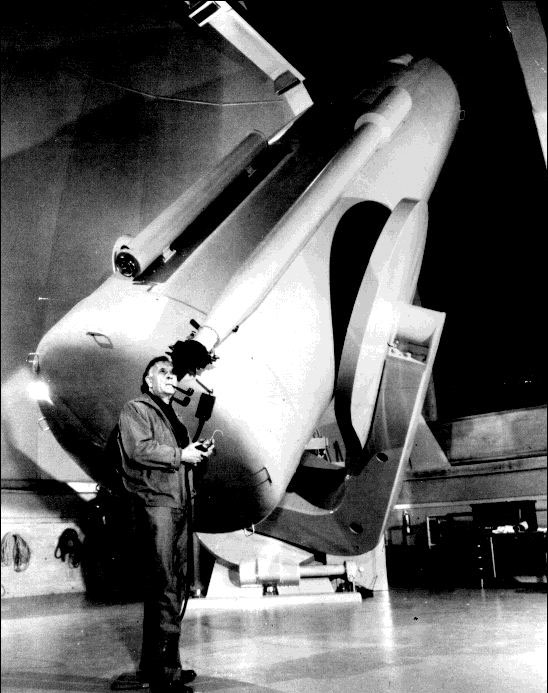 |
| Edwin Hubble at the 48" Schmidt
Telescope, Palomar Observatory, 1949. © Copyright
California Institute of
Technology. | | |
By
measuring the extent of these Doppler shifts with his assistant, Martin
Humason, Hubble came to the startling conclusion that the galaxies weren't
shifting around in a random way. Instead, most were moving away from the
Milky Way at the speed of hundreds of kilometers a second. Although he had
a relatively small amount of data, Hubble was able to model the data with
a simple calculation in his 1929 PNAS paper. Combined with Hubble's
earlier measurements of galaxy distance, the conclusion he drew became
what is now known as Hubble's Law: the farther away a galaxy is from the
Milky Way, the faster it's racing off into the cosmos.
The usual example for Hubble's law is a raisin cake, says Neta
Bahcall, an Academy member and astronomer at Princeton University. "Put a raisin
cake in the oven, and it's very small. Then you let it go, and the
distance between the raisins is like the distance between the galaxies -
it gets larger and larger with time," she said. The inescapable deduction
is that the universe, like the cake, is also growing larger and larger,
expanding indefinitely with time.
|
|
An Uncertain Future

Since Hubble's 1929 PNAS paper, the science of cosmology has
expanded almost as much as the universe. Today, thousands of scientists
all over the world study the tenets of cosmology, including the origin,
structure, and relationships of objects in the universe. At least 31
universities in the United States offer doctoral programs in the field,
and several journals, including The Astrophysical
Journal, The
Astronomical Journal, and PNAS, regularly publish new cosmological
research.
 |
Currently, researchers who have continued Hubble's study of the
expanding universe have come to their own surprising conclusion--that the
rate of expansion seems to be accelerating. Results from two independent
teams of scientists, published in 1998 (4, 5), show that
galaxies are moving apart more quickly with time. Hubble originally
estimated the rate of expansion--found by dividing velocity by
distance--to be about 500 kilometers/second/megaparsec (a megaparsec is
3.26 million light years). However, this number, known as Hubble's
Constant, has since been radically revised because initial assumptions
about stars yielded underestimated distances. The most recent estimate of
the expansion rate, computed with data from the Wilkinson Microwave Anisotropy Probe,
is about 71 kilometers/second/megaparsec, and accelerating.
"Very nearby, Hubble's Law is very good. But we've found that if
you look over big enough spans of distance, the distance and velocity are
not exactly proportional to each other," said Robert
Kirshner, an Academy member and astronomer at Harvard University.
Researchers aren't sure why the expansion is accelerating, but it
may have to do with a substance known as dark
energy. Completely undetectable by scientists and currently only a
theory, dark energy may be driving the acceleration and defying gravity's
pull. Kirshner says that the amount of invisible dark energy in the
universe may far exceed other visible material, such as stars and
planets.
"The universe may be like Los Angeles," Kirshner jokes. "It's
one-third substance and two-thirds energy."
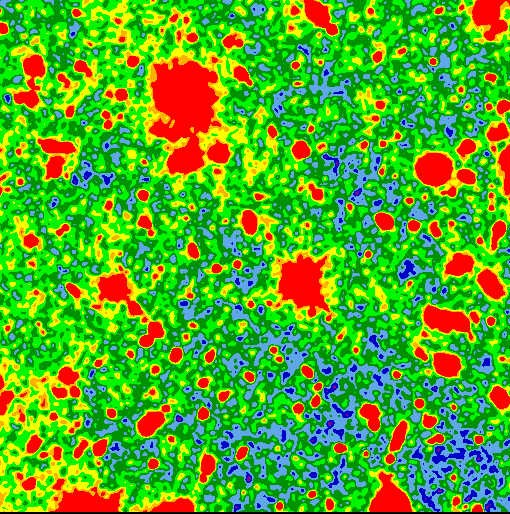 |
| A false-color image of the Hubble
Space Telescope's "Deep Field." Red regions correspond
to galaxies and stars. Space Telescope Science
Institute.
| | |
However, scientists studying this phenomenon are equipped with
better tools than in Hubble's day. Mt. Wilson Observatory is rarely used
now due to light pollution, but several 200-inch telescopes have since
been built, and a pair of 400-inch telescopes currently operate at Keck Observatory in Mauna Kea,
Hawaii. Additionally, a satellite launched in 1990 carries the Hubble Space Telescope, capable of
viewing galaxies more than 10 billion light years away. Each of these
telescopes is equipped with digital light detectors far more sensitive
than Hubble's photographic plates.
Currently, researchers are using another powerful telescope to
conduct the Sloan Digital Sky Survey,
the largest study of galactic velocities to date. The results of this
research may provide some much-needed insight into the future of our
universe, continuing Hubble's goal of understanding our cosmos. However,
new findings are likely to spur an additional round of questions, similar
to the uproar that followed publication of Hubble's original 1929
research.
"We used to be able to explain what the universe was doing to our
students and now we can't anymore," said Haynes.
|
|
References

1. Hubble, E. (1929) Proc. Natl. Acad. Sci. USA
15, 168-173.|Article|
2. Leavitt, H. (1912) Harv. Coll. Obs. Circ.
173.
3. Hubble, E. (1925) Astrophys. J.
62, 409.
4. Schmidt, B. P., Suntzeff, N.
B., Phillips, M. M., Schommer, R. A., Clocchiatti, A.
Kirshner, R. P.,
Garnavich, P., Challis, P., Leibundgut, B., Spyromilio, J., et al.
(1998) Astrophys. J. 507, 46-63. |Article|
5. Perlmutter, S., Aldering, G., Della Valle, M., Deustua,
S., Ellis, R. S., Fabbro, S., Fruchter, A., Goldhaber, G., Goobar, A.,
Groom, D. E. et al. (1998) Nature (London) 391, 51-54. |Article|
|
| |
|
![]()



 galaxies were redder
galaxies were redder

